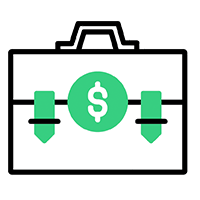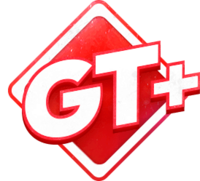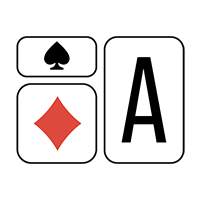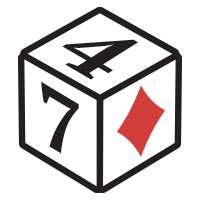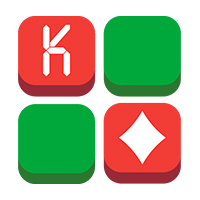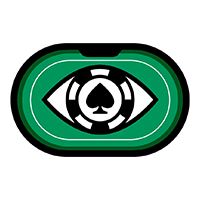2006, I'm in the 10th grade. One day, after solving math Olympiad problems, my friend and I were returning home from school in a crowded Moscow trolleybus. He told me about the Million Dollar Homepage . I felt a mixture of envy and disappointment. The idea was so simple, I could do it myself! A million dollars was my cherished dream, but it seemed like an unrealistic fantasy. I grew up in a very poor family, and the richest person I knew earned $2,000 a month working as a programmer at a bank. So my friend and I were constantly coming up with unrealistic money-making schemes.
Over the next few years, I competed in programming competitions and studied mathematics at university, which I eventually dropped out of in 2010 to play poker. At the peak of my career, I was playing NL5k shortstack, but then I had to drop down to NL1K. And in 2013, I created and sold the world's first Hold'em solver.
2-7 Triple Draw
In the summer of 2013, after we had already agreed on the Hold'em solver, Trueteller and I were chatting on Skype. He suggested that a solver for an exotic poker game called 2-7 Triple Draw would earn me at least a million dollars. Hearing this, I felt a surge of euphoria – finally, I would be able to make my fantasies come true. Trueteller knew exactly what he was talking about. PokerStars, at the time, had regular $1,000/$2,000 play, and no low- and mid-stakes play at which players could practice. This made the hypothetical solver even more valuable.
I started thinking about a solution.
The Technical Details
The game seemed impossible to solve in its entirety, so we manually developed strategies for preflop and 1st draw. This allowed us to find separate solutions for each leg, starting with the second street of betting. A similar approach was used in my Hold'em solver, where the game was solved starting with the flop.
One full strategy calculation took 3 days and cost me $1,000 in server rental. Taking into account experiments and iterations, I calculated about 20 different versions.
Once we had found all the flop strategies, we calculated the preflop EV and identified hands for which the current strategy did not maximize EV. With this information in mind, we manually made changes to the preflop strategy and ran the next iteration.
We quickly realized that there was a huge value in the cards that players discarded when trading. So I upgraded the solver to take into account one discarded card. This required an incredible amount of effort, but as you'll see below, it paid off handsomely.
After a year, I was able to improve the solver so that the strategy was calculated starting from preflop. This was a breath of fresh air – no longer did I have to make 30 new calculations each time, which then had to be combined with the strategy obtained manually. Also, solutions starting from preflop are usually more accurate.

By 2024 I have a pretty good solution for 6-max thanks to improved algorithms, efficient game tree construction, abstraction techniques, and computer advances in using large amounts of RAM.
Making a Deal
Once I was sure the solver worked, we moved on to negotiations. It would have been a bit odd for clients to agree to pay me hundreds of thousands of dollars for solutions they couldn't verify. But I had no doubts about the accuracy of my software, so Trueteller and Raul Gonzalez agreed that I would have 40% of their results (including losses), with my share gradually decreasing to 10% over the next two years.
At that moment, two years seemed like an incredibly distant future to me, so I bargained without enthusiasm. It is clear that my solver brought profit to clients for much longer. Now I charge more from new clients.
However, everything worked out perfectly in our relationship because:
a) They learned the game from scratch, and all the profit was obviously related to using my solver.
b) All online games were public, so the results were easy to track.
Our collaboration really motivated me to improve the solver.
Raul's comment:
– Working in the 2-7 solver was the best learning process in my entire poker career. I often asked for a new feature to be added, not even knowing how it should look or if it was even possible. But after 1.5 hours you sent me a new version, in which the feature was implemented even better than I could have imagined. And often added something useful from yourself.
The changes concerned hand filters, displaying strategy and EV of hands. I also added the ability to play one specific spot in the simulator, rather than entire hands. An important addition was the function for analyzing the history of hands from Stars, which allowed us to see where the biggest mistakes were made.

We signed an exclusive contract for two years (2014-2015). I am not a fan of secrecy and exclusivity, but at that moment, for this game specifically, this option was ideal.
But I couldn't have a direct share of 40% in such an expensive game. Given the variance, a $1,000/$2,000 limit requires a bankroll of over $1 million, and I didn't have that kind of money at the time. We found an elegant solution called Indirect Share. Under the new terms, I had a freeroll and received 40% of the EV.
We calculated the exact share post factum based on the results of a 6-month period, taking into account the number of hands against each opponent, win rate and standard deviation (Detailed description of the method in English and calculator ).
I had thoughts about learning to play myself. I even studied 5-card draw poker for a while. However, developing and implementing poker strategies requires a lot of effort and time, so I eventually decided to focus on software development.
Trueteller and RaulG took the time to learn, and within a couple of months they were battling heads-up and 6-max tables at $2,000/$4,000. One of their regular rivals was Gus Hansen. Hansen is a strong, talented player. But he was giving non-stop action to the best players in the world who dedicated their lives to poker. It’s no wonder he was losing.

King of the Hill at PokerStars
We're talking about a system that PokerStars introduced many years ago for heads-up cash tables. Regulars were deprived of the ability to open multiple tables and sit around waiting for the fish to come in. If someone sat down at a $2,000/$4,000 table, everyone else was forced to either join them and play, or leave the lobby and lose their chance to play against a weak opponent.
Until 2014, the high-stakes 2-7 triple draw tables on PokerStars were run by a group of regulars. No pro dared challenge them. A few years later, we learned that they had a solver, too, but it didn’t take into account the cards players throw away on the draw. My solver only took one such card into account, but even this improvement opened our eyes to a completely new strategy: on the third betting round (after the second draw), tricky raises with T-high appear if both opponents have drawn one card.
They were sure they knew the real GTO strategy, and Raul and Trueteller, in their opinion, played a little weird. So they kept giving action. In the end, they played 40,000 hands, during which they lost us about $700,000 and then finished. We estimated our edge at about 1bb/100. But, even without the blocker, I think Trueteller and Raul played better.
They started playing 2-7 a year earlier, no one really resisted them, and they managed to earn at least $10 million.
In 2014, French journalist Victor Saumon made a documentary film, Nosebleed, about limit game regulars Alex "Alexonmoon" Luneau and Sebastian "Seb86" Sabiche.
At the 53rd minute they had a dialogue:
Lee "Enon" Goldman: Did you find any online action while you were in London?
Seb86: Played 2/4 with Trueteller and Raoul for a bit.
Lee "Enon" Goldman: How are they?
Seb86: Not bad now. Both are playing well.
Alexonmoon: Yeah, it's getting tougher.
Too Much Money
From 2013 to 2015 my bankroll grew from $20,000 to $1,000,000, psychologically it was difficult for me to get used to it.
The streaks were incredible. On his best day, Raul won $704k, and on his worst day, he lost $346k.
I wasn't prepared for such amounts. When I was a professional, I never declared more than $2,000 at the table, and my record result for a session was $10,000. And when Trueteller and Raul played, I personally played $50-100k per day.
To distract myself, I dove headfirst into Dota 2. In 2014, I played 2,000 hours of the game, three times marathoning 24+ hour sessions. I only took short breaks to add new features to the solver.
I asked not to send me daily reports (The only exception was for sessions in which a certain negative threshold was overcome. I needed this to rebuild my bankroll management). Financial calculations were made every 3-6 months.
It's embarrassing to admit, but I've never watched my clients play live – either online or offline. There's something scary about being able to see the results of your work in real time.
Here's an example of a tough hand where both players I had cut from didn't commit $980 to a $120,000 pot:
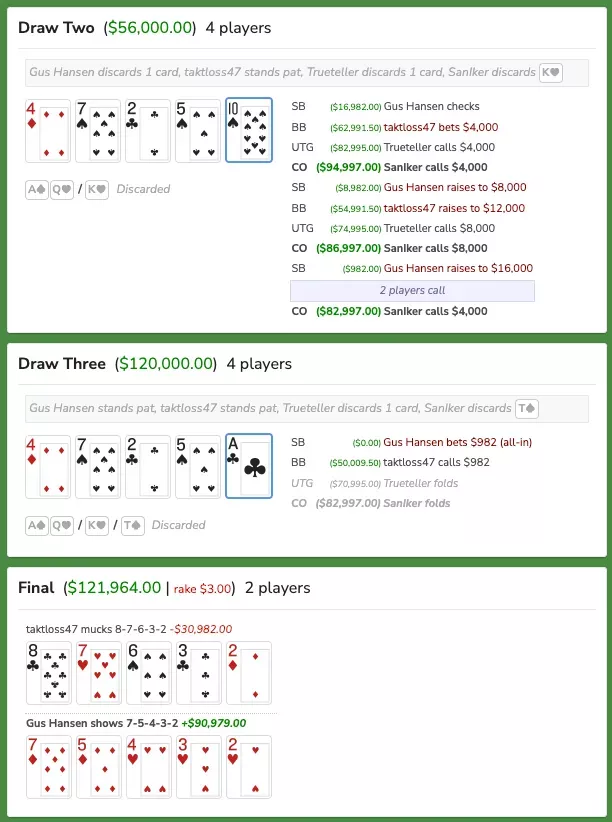
It's still a good thing I never followed their game...
The Impact the Solver Had on Me
It was a pleasure to create a unique product that helped people reach the very top.
In my youth, this constantly depressed me – there were always classmates who were smarter, I never took first place in math and programming Olympiads, and I couldn’t reach the top in poker either. At the peak of my career, I played NL5,000 with a short stack, but that didn’t last long either.
With the 2-7 solver I finally felt like I was the best in the world at something. I was working with real legends and we were up against legends too.
Epic hand against Phil Ivey :
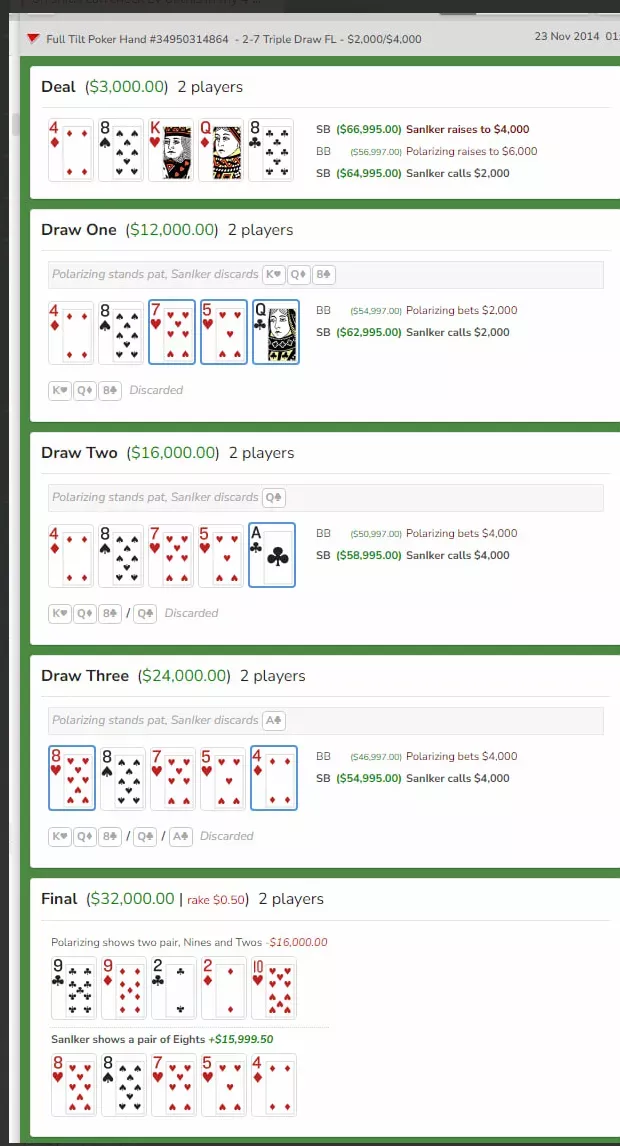
Raul's comment:
– I made an instant call, and in the next hand he spent almost the entire time bank preflop. My exploit was that there were almost no thin value bets back then, no one would bet 9-high in such a spot. So blockers on 8 turned out to be very important.
But Phil Ivey was soon faced with a more serious confrontation.
Timofey "Trueteller" Kuznetsov vs Phil
In November 2015, when 2-7 action finally died, Trueteller challenged the most legendary player of the time.
They played 40,000 hands in 8 games at the $400/$800 limit. Timofey won 1.3BB/100 or $400,000 at the table, but there was also a crossbook. I can't go into details, but it got to 10x.
This match brought me about $200,000. It was especially nice to beat a living legend.
During preparation, Timofey used solvers for 2-7 and razz. We also developed an exploit strategy for FLHE.
I'll tell you more about this another time.
Timofey recalled this confrontation on the pages of his blog :
– In 2014, after the NL 6-max action died down and Gus and Samrostan lost the rest of their online bankrolls in 2-7, I was faced with the question: who should I play big with now? The biggest potential opponent online was Ivey, but he didn’t play with me in NL and 2-7 anymore, and I didn’t know how to play other games at the time. I came up with a plan: learn to play 8 games well enough in a year to start a match with him without a big underweight, and then watch. It would be hard for him to stop playing his best discipline against a young, inexperienced opponent in mixes.
Vegas Cash Game
Another option for playing 2-7 Triple Draw was in Las Vegas, where the format was part of a high-priced mix. The game is played every year during the World Series, with the big blind ranging from $3,000 to $5,000 and a rotation of 10 to 15 different games.
Trueteller played 2-7 so well that eventually Doyle Brunson and others voted for an "anti-Timofey mix" that did not include 2-7 triple draw, NLHE, or PLO.
Jungleman
In 2017, Trueteller introduced me to Jungleman. I helped him master 2-7 triple draw, NL2-7 single draw, Razz, and Omaha.
In 2021 and 2022, Jungleman won the $50,000 Players Championship back-to-back. It was great to be part of such a resounding success on the biggest stage in poker. In our interview, Jungleman went into more detail about how he prepared, how the solver affected his win rate, and how many hours he spent studying.
You can play 2-7 against a solver for free at draw.olegsolvers.com. For the full version, contact me personally, the price starts at $13,900.
Special thanks to Volker "RaulG" for hands and results. Thanks to Timofey "Trueteller" and Daniel "Jungleman" for help with the article. Thanks to R. Nikhil, Joe Ingram, Ian Chen, Alex "Kanu7'" Millar, Alexander Elensky, and Ivan Bogatyi for reviewing.


